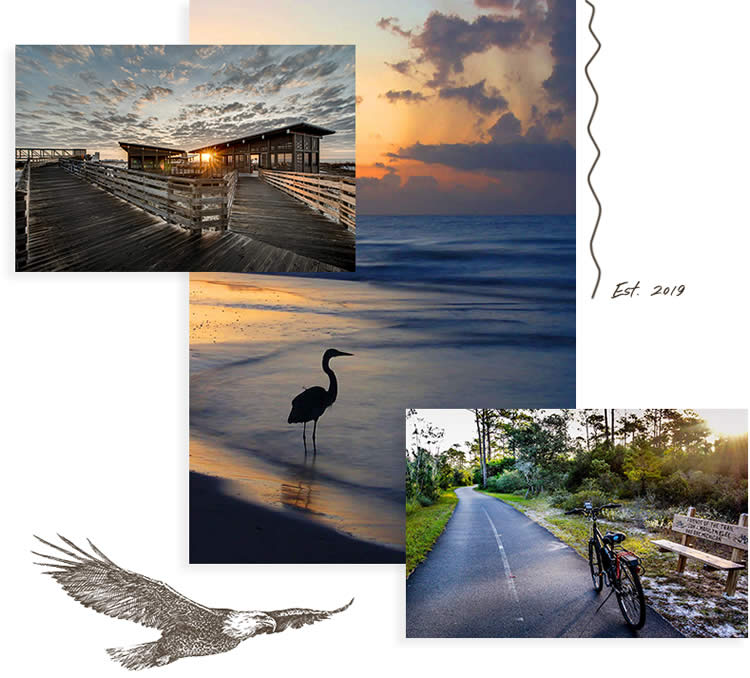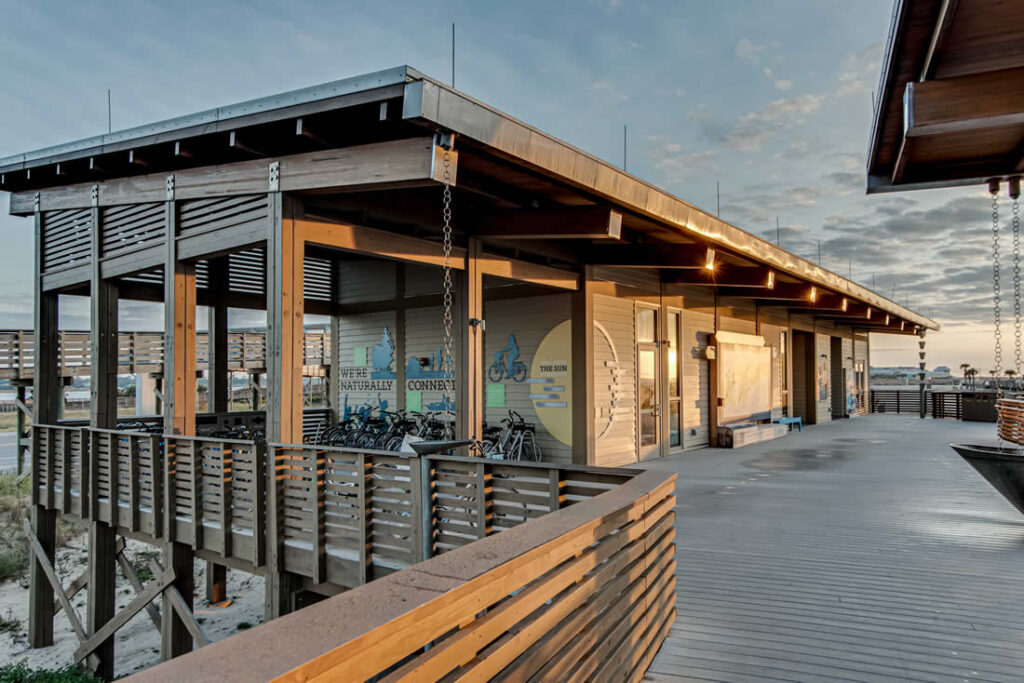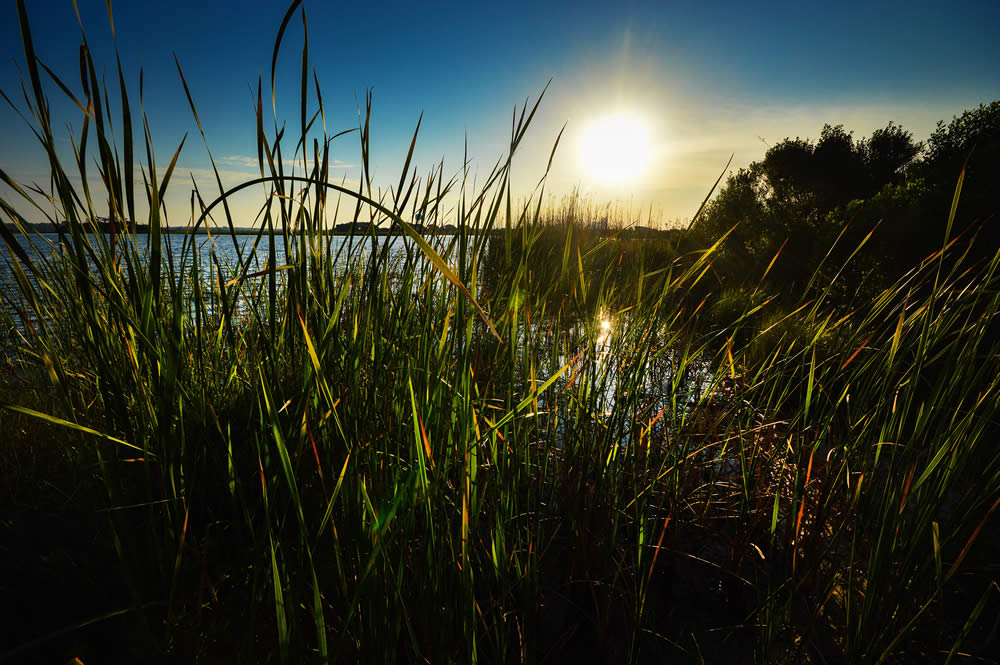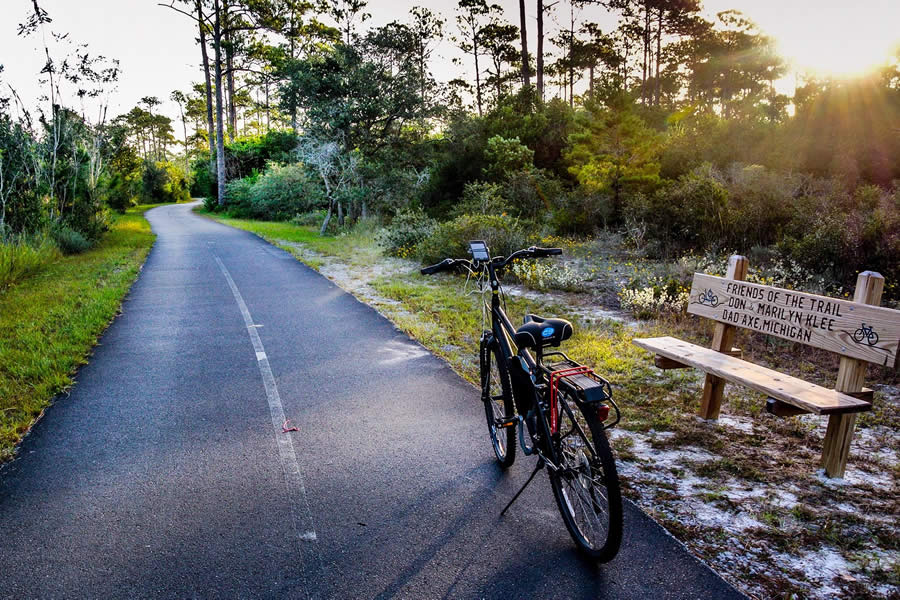When the Gulf State Park Enhancement Project was announced in 2014, we made it our mission to provide the most ecologically-sensitive enhancements to the Gulf State Park and lead the way for sustainable architecture and operations.
When the Deepwater Horizon oil spill occurred in 2010, the Alabama Gulf Coast was severely damaged. Fortunately, restoration funds have provided an opportunity for us to make a sustainable impact and improve the damage.
Learn more about our efforts to elevate the Gulf State Park, protect the precious ecosystems on the Gulf Shore, and how you can join us to contribute to a sustainable future.

To create the ultimate sustainable environmental experience, our mission statement is to be an international benchmark for environmental and economic sustainability, demonstrating best practices for outdoor recreation, education and hospitable accommodations.
Every action we take must adhere to our three key principles: environmentally-friendly practices, support for the protection of cultural and natural heritage, and being a benefit to local people. Through the Gulf State Park Enhancement Project, we have made significant progress to adhere to our park’s values.
The master plan for the Gulf State Park Enhancement Project is funded by BP contributions to compensate for the Deepwater Horizon oil spill. Restoration monies go towards enhancing the park through new developments.
Our vision is to elevate Gulf State Park as the premier ecotourist destination in the Southeast and to serve as the international standard for the future of environmentally-conscious construction and sustainability efforts.

The first part of our plan consisted of restoration and upgrades for the park funded by the Natural Resource Damage Assessment Process (NRDA). We constructed the brand new Learning Campus, Interpretative Center, and restored the state-owned lodges.
Additionally, we enhanced trail paths throughout the park and worked diligently to restore dunes. Natural disturbances, such as hurricanes, floods, and fires have impacted the historic dunes in the park. A number of endangered species inhabit Gulf State Park’s dunes, including the Alabama beach mouse. The wildlife restorations have already made a dramatic impact to protect these sensitive species and efforts have helped build healthy dunes that will sustain over time.
Our efforts to restore the dunes include:

Phase two identifies additional opportunities to further strengthen the economic potential of the park, including additional trail enhancements, campground improvements, golf course conversion and construction of a park tram.
Phase two continued efforts to elevate the Gulf State Park. We enhanced many of the trails in the park and added new trails for visitors to explore. We improved campground areas for safer and more comfortable sleeping destinations for outdoor enthusiasts. We also introduced a new park tram for a more efficient exploration of the park.
Unfortunately, we have had to close the Gulf State Park golf course because it does not align with our mission for sustainability. The average American golf course consumes 50 million gallons of water per year and courses are sources of pollutants that may affect the Gulf Shores. Phase two addressed the conversion of the golf course.

Phase three focused on long-term improvements to the park, so visitors get more out of their time while visiting. We renovated and developed new picnic areas across the park for more comfortable outdoor dining experiences. Also, we enhanced a number of trails in the park and improved beachfront parking for more convenient and stress-free visits to the Gulf Shore.
Beachfront enhancements encourage walking, bicycling, and sustainable travel. We engineered the new parking arrangements for ecological improvements. We integrated the Park Tram, bike paths, and walkways to improve access to the park without using a motorized vehicle. We added drop-off zones for convenient unloading at the park or pavilion with parking. Finally, we have incentivized non-motorized travel by reducing the cost of pier admission with a parking charge. Visitors can now access the beachfront areas easier and more responsible than ever.
We expanded the trail network by nearly 28 miles and created multiple car-free loops for environmentally-friendly travel. The trail network enhancements helped improve the ecological connectivity throughout the park and made it more convenient for travel on foot or bike. We convertedRattlesnake Ridge and Cotton Bayou to unpaved surfaces and widened Catman Road trail. Additionally,we resurfaced Powerline North to unpaved and improved hydrological connectivity under the trail.
The final part of Phase 3 was to improve the accommodations around Lake Shelby. We enhanced picnic areas and added additional cottage and cabin areas to invite more overnight families and park visitors to camp out. We improved circulation for travelers parking at Lake Shelby, so they can access a variety of trails from their arrival destination. Finally, we enhanced the dog park and added a nature-based play area for children.
The ultimate goal of our master plan was to enhance and elevate the Gulf State Park as one of the top ecotourism destinations in the country.
Creating a pristine ecotourism destination for visitors is at the heart of our mission to restore and improve Gulf State Park. Ecotourism encourages responsible travel to natural environments and aims to create sustainable and conscious protection of the natural environment.
We’ve enhanced previous areas in the parks to reduce the carbon footprint from visitors and promote responsible experiences to preserve resources and protect the environment. In addition, the new buildings constructed from the Gulf State Park Enhancement Project adhere to the strictest environmental precautions.
For instance, the new Interpretive Center is LEED-certified (Leadership in Energy and EnvironmentalDesign) and engineered to reduce harmful emissions and contribute to the lowest environmental impact as possible. We’ve also eliminated single-use plastic products on the property, use only biodegradable and recyclable materials, and engineered the park to encourage non-motorized travel.
Environmental sustainability is the goal of all our efforts to promote the ecological health of the park.Since the Gulf State Park is one of the only destinations that encompass nine different ecosystems, it is the ultimate tourist destination for outdoor and environmental enthusiasts. Our efforts ensure that each ecosystem is protected from harm and that visitors and construction contribute to a minimal ecological footprint.
Constructing energy-efficient buildings and engineering park designs for sustainable travel is just the beginning of the mission. To promote environmentally friendly operations and to support the protection of natural landscapes, we’ve also introduced new initiatives for ongoing sustainability:
Whether you are visiting Gulf State Park for a relaxing weekend or want to join our environmentally conscious initiatives, we have a spot here for you! Contact us to learn more about our sustainable efforts and help promote environmentally friendly living in your community. Let’s make a difference together!